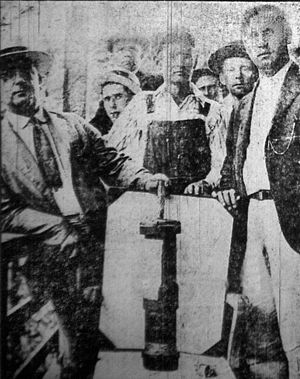 Coal miners displaying a bomb that was dropped during the Battle of Blair Mountain in 1921 | |
| Date | 1912–1921 |
|---|---|
| Location | West Virginia, United States |
| Also known as | Mine wars |
| Participants | Coal company security/detectives, West Virginia state and military forces, U.S. Army and U.S. Army Air Service forces against striking miners |
| Outcome | Law enforcement-military victory; Bill Blizzard acquitted of treason; other miners jailed for murder charges and other offenses; mining union membership decreased by 50% from 1921 to 1924 |
The West Virginia coal wars (1912–1921), also known as the mine wars, arose out of a dispute between coal companies and miners.
The West Virginia mine wars era began with the Cabin Creek and Paint Creek strike of 1912–1913.[1] With help from Mary "Mother Jones" Harris Jones, an important figure in unionizing the mine workers, the miners demanded better pay, better work conditions, the right to trade where they pleased (ending the practice of forcing miners to buy from company-owned stores), and recognition of the United Mine Workers (UMW).[2]
The mining companies refused to meet the demands of the workers and instead hired Baldwin-Felts agents equipped with rifles to guard the mines and act as strikebreakers.[2][1] After the Agents arrived, the miners either moved out or were evicted from the houses they had been renting from the coal companies, and moved into coal camps that were being supported by the Union.[1] Approximately 35,000 people lived in these coal camps.[1]
A month after the strike began, hostilities began with the arrival of the Baldwin-Felts Agents who provoked the miners.[1] Socialist Party activists began supplying miners with weapons: 6 machine guns, 1,000 rifles, and 50,000 rounds of ammunition.[1]
On September 1, 1912, approximately 6,000 unionized miners from across the Kanawha River crossed the river and declared their intent to kill the mine guards and destroy the company operations.[1] Due to this threat, the mining companies deployed additional armed guards and awaited the miners' attack.[1] Consequently, the Governor proclaimed martial law to be in effect on September 2, 1912, seizing 1,872 rifles, 556 pistols, 6 machine guns, 225,000 rounds of ammunition, and 480 blackjacks – as well as large quantities of daggers, bayonets, and brass knuckles.[1]
On May 19, 1920, a shootout in Matewan, West Virginia, between agents of the Baldwin-Felts and local miners, who later joined the United Mine Workers of America, sparked what became known as the Battle of Blair Mountain, the largest insurrection in the United States since the American Civil War.